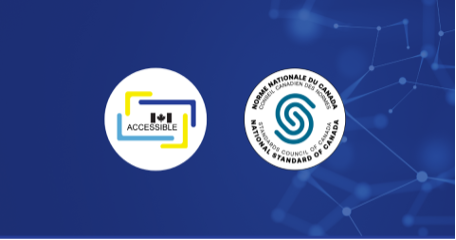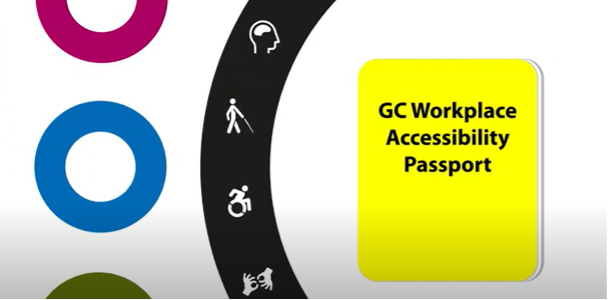July 2024 AAACT Now for AccessibilityNewsletter
In this edition: accessibility requirements for ICT; information on accessible ICT procurement; GC Workplace Accessibility Passport.
Welcome to the summer 2024 edition of AAACT Now For Accessibility, the newsletter from Shared Services Canada’s Accessibility, Accommodation and Adaptive Computer Technology (AAACT) team. This newsletter includes news and insights on digital accessibility so we can all contribute to disability inclusion.
Latest News
Shared Services Canada has launched an open tender for Accessibility Conformance Testing and an Indigenous Business Set-Aside for Accessibility Conformance Testing. Through these tenders, we are seeking offers to provide accessibility conformance testing against Information Communication Technology (ICT) accessibility requirements in the following categories: Web, Non-web documents – PDF, Non-web documents – Non-PDF, Non-web software, iOS Native Mobile Applications, Android Native Mobile Applications and Hardware ICT. All required supporting documentation and bid submissions must be submitted by August 19, 2024, 2 p.m. EDT.
National Standard of Canada on Accessibility Requirements for ICT

Alt text: Logo for the National Standard of Canada and Standards Council of Canada.
Accessibility Standards Canada is adopting the Harmonised European Standard EN 301 549 as a National Standard of Canada. The standard, announced on May 31, 2024, features accessibility requirements for a wide range of ICT products and services including web-based technologies, non-web documents, software and hardware, and outlines procedures to evaluate each accessibility requirement. The standard supports the goal of the Accessible Canada Act, to realize a barrier-free Canada by 2040.
“We welcome the adoption of the EN 301 549 standard as a National Standard of Canada. The AAACT team currently uses the EN standard to guide accessibility testing and accessible procurement work,” says Nadine Charron, Senior Director of AAACT. “We are excited to continue to work with GC partners to support the adoption of this standard and to continue advancing accessibility across the federal public service.” AAACT has been formally piloting the implementation of the EN 301 549 in some ICT procurements since 2018 and has consulted and collaborated with other jurisdictions on the pilot implementation of the EN 301 549.
To learn more, visit Accessibility Standards Canada’s Our standard on Accessibility requirements for ICT products and services web page.
Accessible ICT Procurement
Our team provides expert guidance and training on procuring accessible ICT solutions for all GC departments and agencies, and other jurisdictions upon request. We support clients through every phase of the procurement process from including accessibility in their technical requirements right through to the project rollout. AAACT’s goal is to help Business Owners make accessibility-related decisions that facilitate the purchase of goods and services by the GC. This helps ensure that these purchases are built to an international ICT accessibility standard and are accessible by design, allowing everyone to use them seamlessly. Building accessibility into ICT products and services from the start can reduce costly remediation work and accommodations needs in the future.
Departments are required to consider accessibility when purchasing goods and services. Where the goods or services have ICT components, this involves requiring suppliers to conform to the Harmonised European Standard Accessibility requirements for ICT products and services (EN 301 549 v3.2.1 (2021-03)), focusing on end users, and addressing any barriers they might encounter with the goods or services being acquired. It isn’t sufficient to plan for current users; looking to future users is recommended.
There is no one-size-fits-all approach to accessibility. By consulting on accessibility requirements at the outset of the procurement process, we can reduce long term costs by incorporating flexibility and avoiding the need for subsequent remediation of goods or services which never considered accessibility in their design.
To learn more or to find resources to help incorporate ICT accessibility standards into your procurement processes, check out the external facing Digital Accessibility Toolkit procurement page. For GC employees, an internal facing toolkit is available on the TBS (Treasury Board Secretariat) OPSA GCpedia procurement page (Procurement – GCpedia).
Visit our GC Accessibility Training and Events page to learn about upcoming training opportunities on accessibility in procurement. (You need to be on a GC network or connected through a Virtual Private Network to access GCPedia.)
For advice and guidance on accessible ICT procurement, reach out to AAACT.
GC Workplace Accessibility Passport

Alt text: GC Workplace Accessibility Passport branding
Are you a GC employee facing barriers in your workplace? Are you a manager working to create an inclusive work environment for all employees? The GC Workplace Accessibility Passport is here for you.
The passport facilitates open and collaborative conversations between an employee and their manager about the barriers the employee faces at work as a result of a permanent, temporary, or episodic disability. The Passport is a tool that focuses on the employee’s work situation to document the barriers they encounter in that situation and the solutions to equip the employee for success. The objectives of the Passport are to simplify the accommodation process by serving as a record of an agreement between the employee and their manager and avoid requests for proof or documentation.
The Passport puts the employee at the center of the workplace accommodation process. When they complete a Passport, employees decide when and with whom to share the information it contains. Employees should share their passport with their new manager when they change jobs or move to a new GC organization. This allows for seamless and consistent support throughout their career. Federal organizations are responsible for adopting and promoting the use of the passport to improve the accommodation process. The Passport is an accessible MS Word document, available for download on canada.ca, where you will also find videos and other helpful resources.
Work is underway to develop a digital version of the Passport that will be available through the TBS Applications Portal (TAP). For more information and to download the MS Word version of the Passport, visit About the Government of Canada Workplace Accessibility Passport.
Get to Know the Team

Alt text: A picture of Luna Bengio.
Luna Bengio is a powerful persuader when it comes to accessibility. Her depth of professional and lived experiences guide leaders at SSC and across the federal public service to understand the business advantages of accessibility. She says once people see how accessibility benefits everyone, they are more eager to make accessibility part of their daily processes. As a AAACT Senior Advisor, she is also involved in complex accommodations, helping employees across the public service get the workplace tools they need.
Her 30-year career in the public service has spanned training and policy development in various departments. She retired in 2021 as the Principal Advisor to the Deputy Minister of Public Service Accessibility in the Treasury Board of Canada Secretariat. She was involved in extensive consultations with policymakers, public servants at all levels, and external partners in Canada and abroad. Luna laid some of the groundwork for GC organizations to meet their obligations under the Accessible Canada Act. Luna also helped develop and implement theGC Workplace Accessibility Passport. She has recently returned to the public service to continue to advance accessibility.
You have had a full and varied career in the public service. What motivated you to return as a consultant and work specifically in accessibility?
Throughout my career, I made a very conscious decision. I did not want to be the person with a disability always working on disability issues. I wanted to prove that I could do something else. That was important for me. After I retired, I wanted to give something back. I continue to see so many employees with disabilities struggle to get what they need to have a level playing field in the federal public service.
You know firsthand what it takes to level the playing field. Can you share some of your experiences?
I was born with a degenerative condition and have faced accessibility barriers throughout my life. I was always legally blind. For work, I used magnification to read documents and use the computer, until about 25 years ago. That’s when I started using a screen reader. That’s my main accommodation. If I have my screen reader and accessible documents, presentations, and applications, then I’m good.
It is important to recognize that people can function differently and still function very well. I have encountered barriers in my interactions with a world that is not made for a diverse population. That needs to change.
If you could use this platform, the_AAACT Now for Accessibility _newsletter, to speak to senior leaders at SSC and across the public service, what would you tell them?
Accessibility can’t be improvised; it must be done deliberately and requires expertise. If we want a public service that is truly diverse, then people with disabilities need to be hired, promoted, and retained.
Accessibility is necessary for all employees across the GC to have a positive experience. We have a way to go with the GC in terms of digital accessibility. We create documents that aren’t accessible and host meetings that people can’t access because of physical or technological barriers.
We need adjustments in our workplaces in order for employees to thrive and be productive. That’s the role of the AAACT team. We provide the tools and techniques so employees across the public service can be as productive as possible, as quickly as possible.
To learn how AAACT can help you and your team, drop us an email at aaact-aatia@ssc-spc.gc.ca.
Upcoming Accessibility Training and Events
The AAACT offers a range of free accessibility training and events for all GC employees. In September, we will host a session on accessibility features on smartphones and adaptive technology in the workplace. This session will help you learn the features that are built into Android and iOS devices and that can be used on your GC-issued smartphone. In addition, you will learn the types of adaptive technology in use on GC computers and how they assist in removing barriers to accessibility.
Also in September, Public Services and Procurement Canada’s Accessible Procurement Resource Center and AAACT are hosting an introductory session on how to consider and integrate accessibility in procurement. This information session is an excellent opportunity for you and your Technical Authority/Business Owner to learn about:
- What accessible procurement means;
- The role of business owners (client department or agency, Technical Authority) and Contracting Authorities in considering accessibility in federal procurement;
- The steps to consider and integrate accessibility in procurement; and
- Where to find resources and get help.
We encourage you to spread the word to your colleagues or clients.
English and French sessions are available. For the full list of training and events, and information on how to register, please visit our GC Accessibility Training and Events page. (You need to be on a GC network or connected through a Virtual Private Network to access GCPedia.)
Digital Accessibility Hack - Document Accessibility
Making your documents accessible means they will be fully usable by all users, including people using adaptive technology. One important tool for making documents accessible is to use a logical structure of headings and sub-headings. Avoid only using bold or larger fonts for headings. Instead, use built-in heading styles that reflect the structure of your content. This makes it easier to navigate and locate content, especially for those using keyboard access, voice recognition and screen readers.
In addition to headings, the choice of fonts for the body of your text plays an important role in your document’s accessibility. Choose fonts and styles that are easy to read, such as Aptos, Arial, Verdana, or Calibri. For print-style documents, body text should be between 11 to 14 points, while presentations should be 18 points or above. By following these tips, you can enhance the accessibility of your documents.
To learn more about making your documents accessible, visit How to create accessible documents in Microsoft 365 - Digital Accessibility Toolkit (canada.ca).
For additional information, you can also watch the Canada School of Public Service video on Making Documents Accessible (INC1-V46) - CSPS (csps-efpc.gc.ca).
Accessibility Feedback Spotlight
A comment received through the SSC’s accessibility feedback form is that the “software selected through the Request For Proposal (RFP) process is not accessibility compliant”. In this case, addressing the feedback involves several elements that include an accessibility audit which can identify software issues and ensure compliance with the standard for accessibility requirements for ICT products and services. It’s important to raise the issue with the developer, who can then ask the software provider to resolve the issues. To prioritize the improvements, identify a compliance roadmap which can be shared with the developer. Scheduling review periods will help ensure timelines are met. Also, be sure to communicate the barriers to users and identify an alternate approach. Training on best practices for developing and choosing accessible software can help prevent similar issues in the future. By integrating accessibility requirements into ICT procurement processes, we ensure products and services that we buy are accessible, and this can reduce time and resources spent on revisions and remediation.
If you have ideas to improve accessibility at SSC, you can provide feedback on accessibility at Shared Services Canada.
We welcome your story ideas and comments to improve our newsletter.
Please share our newsletter with your colleagues. They can register here.
Accessibility, Accommodation and Adaptive Computer Technology (AAACT) Program
Shared Services Canada / Government of Canada
aaact-aatia@ssc-spc.gc.ca
Contact us for more information about the AAACT Newsletter at our email: aaact-aatia@ssc-spc.gc.ca
Page details
- Date modified: